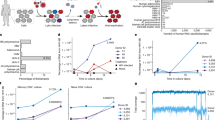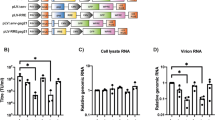Abstract
The in vivo regulation of T lymphocyte activity by the activation of a suicide mechanism is an essential paradigm for the safety of adoptive cell therapies. In light of reports showing that γ-retroviral vector-encoded herpes simplex virus thymidine kinase (hsvtk) undergoes recombination, we undertook a thorough investigation of the genomic stability of SFG-based vectors using two variants of the wild-type hsvtk gene. In a large panel of independent clones, we demonstrate that both hsvtk genes undergo recombination with molecular signatures indicative of template switching in GC-rich regions displaying homology at the deletion junctions or RNA splicing. In the absence of ganciclovir selection, the frequency of recombination is 3% per retroviral replication cycle. Our results underscore the importance of the five nucleotide difference between the two hsvtk genes that account for the presence of recombinogenic hot spots in one variant and not the other, indicating that the probability of RNA splicing is influenced by minute nucleotide changes in sequences adjacent to the splice donor and acceptor sites. Furthermore, our mutational analysis in an unbiased panel of human lymphoid cells (that is, without immune or ganciclovir-mediated selective pressure) provides a robust in vitro assay to predict and quantify clinically relevant mutations in hsvtk suicide genes, which can be applied to studying and improving the stability of any transgene expressed in γ-retroviral or lentiviral vectors.
This is a preview of subscription content, access via your institution
Access options
Subscribe to this journal
Receive 12 print issues and online access
$259.00 per year
only $21.58 per issue
Buy this article
- Purchase on Springer Link
- Instant access to full article PDF
Prices may be subject to local taxes which are calculated during checkout

Similar content being viewed by others
Accession codes
References
Pathak VK, Temin HM . Broad spectrum of in vivo forward mutations, hypermutations, and mutational hotspots in a retroviral shuttle vector after a single replication cycle: deletions and deletions with insertions. Proc Natl Acad Sci USA 1990; 87: 6024–6028.
Pulsinelli GA, Temin HM . Characterization of large deletions occurring during a single round of retrovirus vector replication: novel deletion mechanism involving errors in strand transfer. J Virol 1991; 65: 4786–4797.
Roberts JD, Preston BD, Johnston LA, Soni A, Loeb LA, Kunkel TA . Fidelity of two retroviral reverse transcriptases during DNA-dependent DNA synthesis in vitro. Mol Cell Biol 1989; 9: 469–476.
Varela-Echavarria A, Prorock CM, Ron Y, Dougherty JP . High rate of genetic rearrangement during replication of a Moloney murine leukemia virus-based vector. J Virol 1993; 67: 6357–6364.
Parthasarathi S, Varela-Echavarria A, Ron Y, Preston BD, Dougherty JP . Genetic rearrangements occurring during a single cycle of murine leukemia virus vector replication: characterization and implications. J Virol 1995; 69: 7991–8000.
Bonini C, Bondanza A, Perna SK, Kaneko S, Traversari C, Ciceri F et al. The suicide gene therapy challenge: how to improve a successful gene therapy approach. Mol Ther 2007; 15: 1248–1252.
Garin MI, Garrett E, Tiberghien P, Apperley JF, Chalmers D, Melo JV et al. Molecular mechanism for ganciclovir resistance in human T lymphocytes transduced with retroviral vectors carrying the herpes simplex virus thymidine kinase gene. Blood 2001; 97: 122–129.
Deschamps M, Mercier P, Certoux JM, Henry C, Lioure B, Pagneux C et al. Deletions within the HSV-tk transgene in long-lasting circulating gene-modified T-cells infused with a hematopoietic graft. Blood 2007; 110: 3842–3852.
Frank O, Rudolph C, Heberlein C, von Neuhoff N, Schrock E, Schambach A et al. Tumor cells escape suicide gene therapy by genetic and epigenetic instability. Blood 2004; 104: 3543–3549.
Blumenthal M, Skelton D, Pepper KA, Jahn T, Methangkool E, Kohn DB . Effective suicide gene therapy for leukemia in a model of insertional oncogenesis in mice. Mol Ther 2007; 15: 183–192.
Gallardo HF, Tan C, Sadelain M . The internal ribosomal entry site of the encephalomyocarditis virus enables reliable coexpression of two transgenes in human primary T lymphocytes. Gene Therapy 1997; 4: 1115–1119.
Chalmers D, Ferrand C, Apperley JF, Melo JV, Ebeling S, Newton I et al. Elimination of the truncated message from the herpes simplex virus thymidine kinase suicide gene. Mol Ther 2001; 4: 146–148.
Dang Q, Hu WS . Effects of homology length in the repeat region on minus-strand DNA transfer and retroviral replication. J Virol 2001; 75: 809–820.
De Angioletti M, Rovira A, Sadelain M, Luzzatto L, Notaro R . Frequency of missense mutations in the coding region of a eukaryotic gene transferred by retroviral vectors. J Virol 2002; 76: 1991–1994.
Riviere I, Brose K, Mulligan RC . Effects of retroviral vector design on expression of human adenosine deaminase in murine bone marrow transplant recipients engrafted with genetically modified cells. Proc Natl Acad Sci USA 1995; 92: 6733–6737.
Krall WJ, Skelton DC, Yu XJ, Riviere I, Lehn P, Mulligan RC et al. Increased levels of spliced RNA account for augmented expression from the MFG retroviral vector in hematopoietic cells. Gene Therapy 1996; 3: 37–48.
Wang M, Marin A . Characterization and prediction of alternative splice sites. Gene 2006; 366: 219–227.
ten Dam GB, Zilch CF, Wallace D, Wieringa B, Beverley PC, Poels LG et al. Regulation of alternative splicing of CD45 by antagonistic effects of SR protein splicing factors. J Immunol 2000; 164: 5287–5295.
Goren A, Ram O, Amit M, Keren H, Lev-Maor G, Vig I et al. Comparative analysis identifies exonic splicing regulatory sequences—the complex definition of enhancers and silencers. Mol Cell 2006; 22: 769–781.
Cartegni L, Wang J, Zhu Z, Zhang MQ, Krainer AR . ESEfinder: a web resource to identify exonic splicing enhancers. Nucleic Acids Res 2003; 31: 3568–3571.
Zheng ZM . Regulation of alternative RNA splicing by exon definition and exon sequences in viral and mammalian gene expression. J Biomed Sci 2004; 11: 278–294.
Stoltzfus CM, Madsen JM . Role of viral splicing elements and cellular RNA binding proteins in regulation of HIV-1 alternative RNA splicing. Curr HIV Res 2006; 4: 43–55.
Griffiths A, Coen DM . An unusual internal ribosome entry site in the herpes simplex virus thymidine kinase gene. Proc Natl Acad Sci USA 2005; 102: 9667–9672.
Duch M, Carrasco ML, Jespersen T, Aagaard L, Pedersen FS . An RNA secondary structure bias for non-homologous reverse transcriptase-mediated deletions in vivo. Nucleic Acids Res 2004; 32: 2039–2048.
Zhang WH, Hwang CK, Hu WS, Gorelick RJ, Pathak VK . Zinc finger domain of murine leukemia virus nucleocapsid protein enhances the rate of viral DNA synthesis in vivo. J Virol 2002; 76: 7473–7484.
Ory DS, Neugeboren BA, Mulligan RC . A stable human-derived packaging cell line for production of high titer retrovirus/vesicular stomatitis virus G pseudotypes. Proc Natl Acad Sci USA 1996; 93: 11400–11406.
Markowitz D, Goff S, Bank A . A safe packaging line for gene transfer: separating viral genes on two different plasmids. J Virol 1988; 62: 1120–1124.
Przybylowski M, Hakakha A, Stefanski J, Hodges J, Sadelain M, Riviere I . Production scale-up and validation of packaging cell clearance of clinical-grade retroviral vector stocks produced in cell factories. Gene Therapy 2006; 13: 95–100.
Nolan G . Phoenix-eco Packaging Cell Line. http://www.stanfordedu/group/nolan/retroviral_systems/phxhtml.
Acknowledgements
Genomic DNA from GMC/G1TK cells and PA317-G1TK was kindly provided by C Ferrand, Laboratoire de Thérapeutique Immuno-Moléculaire, Besancon, France. We thank Michael Newman for editorial assistance. This work is supported by P30 CA-008748, PO1 CA-059350, PO1 CA-023766, P50 CA086438 and by Mr William H Goodwin and Mrs Alice Goodwin of the Commonwealth Cancer Foundation for Research and the Experimental Therapeutics Center of MSKCC.
Author information
Authors and Affiliations
Corresponding author
Additional information
Conflict of interest
The authors declare no competing financial interests.
Supplementary Information accompanies the paper on Gene Therapy website (http://www.nature.com/gt)
Rights and permissions
About this article
Cite this article
Wang, X., Olszewska, M., Capacio, V. et al. Quantitative analysis of clinically relevant mutations occurring in lymphoid cells harboring γ-retrovirus-encoded hsvtk suicide genes. Gene Ther 15, 1454–1459 (2008). https://doi.org/10.1038/gt.2008.103
Received:
Revised:
Accepted:
Published:
Issue Date:
DOI: https://doi.org/10.1038/gt.2008.103
Keywords
This article is cited by
-
Adoptive T-cell Immunotherapy of Cancer Using Chimeric Antigen Receptor-Grafted T Cells
Archivum Immunologiae et Therapiae Experimentalis (2010)



